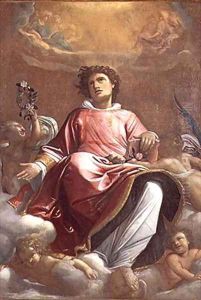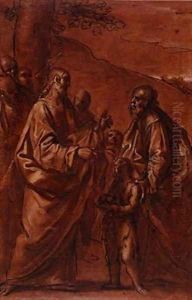Giacomo Cavedoni Paintings
Giacomo Cavedoni was an Italian painter of the Baroque period, born in Sassuolo near Modena in 1577. He is often associated with the School of Bologna, which was a leading center for painting in the period characterized by dramatic light, rich color, and expressive figures. Cavedoni's work was influenced by the Carracci family, notable figures in the Bolognese School, and by other contemporaries like Guido Reni and Domenichino.
In his early years, Cavedoni was apprenticed under Bernardino Baldi and Annibale Carracci, the latter playing a significant role in shaping his artistic style. His initial works bear the strong influence of Carracci's classicism and the vigorous naturalism that the Carracci School promulgated as an alternative to Mannerism. Cavedoni developed a reputation for his ability to portray emotion and expression, a talent that served him well in his religious commissions.
While Cavedoni spent most of his career in Modena, he also worked in Parma and Bologna. His oeuvre primarily consists of religious subjects, fitting the demands of his time when the Catholic Church was the primary patron of the arts and was in the midst of the Counter-Reformation, which called for art that communicated religious themes with emotional involvement and clarity. Some of his notable works include 'The Martyrdom of St. Peter of Verona' for the church of San Giovanni in Monte, Bologna, and 'The Miracle of the Loaves and Fishes' for the Cathedral of Modena.
Despite his considerable skill and contributions to the Baroque movement, Cavedoni did not achieve the same level of fame as some of his contemporaries. Nonetheless, he was highly respected in his time, and his works were sought after by local patrons and religious institutions. Giacomo Cavedoni's death in 1660 marked the end of a career that spanned almost a century of artistic development in one of the most dynamic periods of Italian art history.

